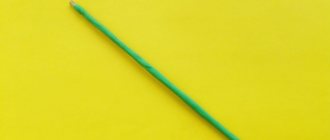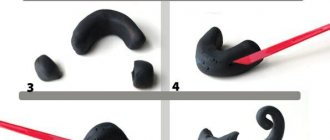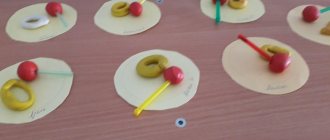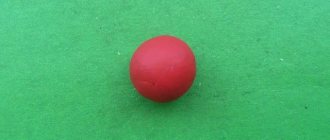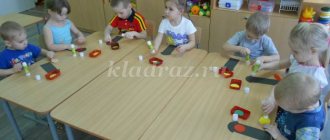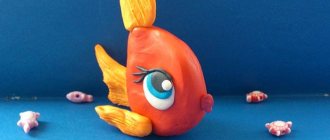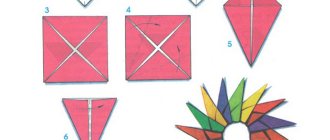Lesson summary for sculpting in 2 ml gr "Sunny"
Lesson in the second junior group on modeling on the topic: “Sun”
Goals:
- To form interest and a positive attitude towards the game, the desire to participate in the general action, to help fairy-tale characters;
- Encourage children to actively communicate and develop speech;
- Consolidate knowledge about the sun (what is it for? what is it like?);
- To teach how to convey the image of the sun, improving children’s ability to roll a piece of plasticine between their palms, giving it a spherical shape; teach the technique of flattening a ball on a horizontal surface to obtain a flat image of the original shape;
- Practice rolling lumps of plasticine between your palms with direct movements of both hands;
- To encourage in children the desire to finish what they start.
Material:
- scenery of a fairy forest, mountains, sun, clouds;
- forest animals: Bunny and Squirrel (roles played by children from the preparatory group);
- record player;
- thick blue cardboard, size - A4;
- yellow and red plasticine;
- hand wipe;
- modeling board.
Preliminary work:
- Walking around the kindergarten area in order to observe the sun (during walks, the teacher teaches children to peer into phenomena, compare them, see what is common and distinctive, and with questions encourages them to find their own words and expressions to describe what they see);
- Reading the fairy tale “Visiting the Sun”;
- Examining the sun in the picture, clarifying the shape and color of the sun;
- Drawing the sun;
- Learning songs and nursery rhymes about the sun;
- Guessing riddles about natural phenomena.
Progress of the lesson
1. Organizational part.
Cheerful music sounds to the tune of the Russian folk song “Shine, shine, sun.” Children sit in a semicircle on chairs, the teacher is in front of them. Behind the teacher there is a scenery of a forest, on the right side of the teacher there is a scenery of a large mountain and clouds.
The music gradually fades away.
Educator
: Guys, listen to a very interesting riddle and tell me what it says:
It warms the whole world and does not know fatigue. He smiles at the window, And everyone calls him...
Children
: Sun.
Educator
: That's right, it's the sun. It wakes up before everyone else, washes itself from the cloud and rises high into the sky to do “good deeds.” And what “good deeds” does the sun do?
Children
: It illuminates the earth and warms everyone.
Educator
: Yes, guys, that’s right, the sun has many “good deeds”: warming the earth, illuminating it with bright light, and waking everyone up with its gentle rays. But sometimes, guys, it happens that the sun does not come out into the sky and does not give us its warmth. Why do you think?
Children
: The clouds are hiding the sun, the sun is sick...
(Several answers from the children).
At that time, Bunny and Squirrel appear from behind the forest. Sad music plays, which gradually fades away.
Bunny and Squirrel
(together)
: Hello, guys.
Children
: Hello.
Bunny
: Squirrel and I came to you for help. For several days now there has been no sun in our fairy tale, and without the sun we are cold, lonely and sad. Guys, help us find the sun.
Educator
: Well, guys, let's help our fairy tale animals find the sun?
Children
: We'll help.
Educator
: Then we need to go with you to a fairy tale. But before we go, let's remember where we can look for the sun? Where does it live?
Children
: Behind the forest there is a big mountain, on a big mountain among the clouds the sun lives,
(Several answers from children).
Educator
: Well, then let's go!
Cheerful music is playing, children and animals are walking through a fairy-tale forest.
Physical education minute
Behind the sun, behind the sun (Walking in place, raising your knees high).
Along the meadow path Let us all go joyfully in the summer time.
The ringing birds are chirping, (Walking, arms up.)
Moths are fluttering,
(Walking with arms flapping up and down).
Dandelions are turning yellow,
(Walk with your body turning to the right, right hand to the side, left hand behind your back and repeat vice versa.
) Cornflowers are turning blue.
Children with animals approach a large mountain with many clouds at the top.
Children and animals (together):
(Russian folk song)
Bucket sunshine! Look out the window! Your children are crying, jumping on the pebbles! The springs are in place.
Sunny, dress up!
Red, show yourself! Jumping in place.
Children and animals call for the sun, but it does not appear.
Educator
: Guys, the sun doesn’t appear, apparently he’s not feeling well. Let's draw him while the sun is sick. Maybe then it will disperse the clouds and begin to give everyone its warmth.
The children go to the tables, the animals remain near the mountain.
Educator
: And we will draw the sun not with pencils or paints, but with the help of plasticine. To make the sun look like a real one, let's remember what it is like. What does it look like?
Children
: On a ball, on a button, on a ball.
Educator
: What color is the sun?
Children
: Yellow, red.
Educator
: That's right, guys.
2. Practical part.
Educator
:
1. You need to take red or yellow plasticine of your choice, divide it in a stack into two parts along the intended line. Place one part between your palms. Roll the ball in a circular motion from left to right (right to left), pressing on it with your palm.
2. Place the finished ball in the middle of the cardboard and lightly press on it, flatten it so that the sun ball is fixed on the cardboard.
3. Pinch off a small piece from the second part, place it between your palms and roll the sausage with straight movements of both hands. Attach the resulting ray-column to the sun and point it to the side, lightly pressing it against the picture along the entire length of the ray. Make the remaining rays in the same way.
Warm up your arms while working
Look: the sun is above us, (Draw
a semicircle with your hand above your head (swinging motion)).
Above the trees,
(Hands raised up, fingers open).
Houses,
(Hands folded over head like a house).
And over the sea, over the wave,
(Draw a wave with your hand).
And a little bit above me.
(Touch your head).
The children finish their work, at this time the sun appears from behind the clouds. The animals jump for joy. Cheerful music is playing.
Educator
: Guys, the sun, having dispersed the clouds, floated into the sky. We managed to help the animals.
The teacher draws the children’s attention to the sun that has appeared. The children are happy. Bunny and Squirrel thank the children for their help.
3. Final part.
Educator
: Today we had a very interesting lesson. Let's remember what we did in class?
Children
: We guessed a riddle, went with Squirrel and Bunny to the sun, called the sun, sculpted a sun, (Several answers from the children).
Educator
: What did you like most?
Children
: When the sun appeared, when the sun was sculpted.
Educator
: Guys, let's enjoy the sun and play a game.
Outdoor game “Sun and Cloud”
To the music of the teacher’s words “The sun is shining,” children run, frolic, and play; on the word “cloud” - the children sit on their chairs.
Educator
: Our lesson is over, you can rest.
GCD in artistic creativity (modeling) in the 2nd junior group
Abstract of GCD on artistic creativity (modeling) in the 2nd junior group Topic: “Barankas for Masha’s doll”
Author: Kuznetsova Anastasia Viktorovna, teacher of MBDOU “Kindergarten No. 95” Semitsvetik”, Ivanovo Description of the material: I offer you a synopsis of direct educational activities for children of primary preschool age (3-4 years) on the topic “Barankas for Masha’s doll.”
This material will be useful to teachers of the 2nd junior group. This summary is aimed at the artistic and aesthetic development of the child using basic modeling techniques: rolling out plasticine with straight movements, bending a stick and connecting its ends to form a ring. Summary of direct educational activities for children of primary preschool age (3-4 years) on the topic “Barankas for Masha’s doll”
Integration of educational areas: “Communication”, “Socialization”, “Artistic creativity”. Objectives: Educational: consolidate the modeling methods (roll out the plasticine with straight movements of the palms; connect the ends of the stick, pressing them together, forming a ring). Educational: develop children's interest in modeling and fine motor skills. Educational: to cultivate accuracy, independence, the ability to complete the work started, following the motivation of the game. Goal: To foster a desire to make something for the game with your own hands. Methodology: “Invite” the doll Masha to the lesson. Invite all the children to make bagels (under the guidance of a doll) and at the end of the lesson, rejoice together at how many bagels the children have made. And the doll Masha will treat the children to real bagels.
Preparatory work: Have a conversation about how autumn is harvest time! Vegetables, fruits and grains are being collected. And from grains they make flour, from which they then bake a lot of delicious things, including bagels! Material: Plasticine, modeling board, doll, bagels, doll plate, music center. Lesson progress: I, doll Masha, hello! I came to visit you and brought you some delicious gifts. The lambs are crispy, look at them, all round and graceful - I sculpted them myself!
Do you want me to teach you how to make delicious bagels? (children answer “Yes”) So listen to me now How we will make them. The teacher and the doll begin to sculpt 1. Take a piece of plasticine, pinch off a small piece, put it in your left palm, cover it with your right hand and warm the plasticine a little, so that our lump is plastic. (warm up the plasticine) 2. Have you warmed it up? Well done boys! Now we put it on the board and with our right hand we roll it a little, but do not crush it. (roll out the stick with straight movements, sometimes with your right hand, sometimes with your left hand) Children roll it back and forth, Calmly, smoothly, slowly. We'll get a sausage. Oh, look! Good! So, now I’ll take a look at yours: (the doll checks each child, helps those who don’t succeed) You’re great! So good! And everything is fine here, everything worked out! Here's another!
3. Now let’s rest a little - Let’s spend a physical education minute: Children get up and take 2 maple leaves from the prepared basket.
stand in a circle. To the music of F. Chopin “Autumn Waltz” they repeat the movements of the teacher. 4. Relaxed! Well, fine! Everyone, sit down and we will do the next thing with you again - Take sausages into everyone’s hands! 5. Got it! Quiet! Look! I take its ends, I connect them both and fasten them. Well done!
6. I succeeded! Now I’ll take a look at yours (the teacher with a doll looks at the children’s work, helps, evaluates) 7. Now there are a lot of steering wheels. Drink tea - don't drink too much. We need to put all our bagels in a saucer now. (children put their “bagels” in a plate) 8. Well, you did the job, everyone tried, they listened! Here is your reward - everyone, eat the bagels! Doll Masha treats children to bagels and thanks them for their difficult work in class.
We recommend watching:
Summary of GCD on gender education in the 2nd junior group. Summary of GCD in the second junior group. Synopsis of GCD in the 2nd junior group. Fun Train Summary of an open lesson for children of the second junior group
Similar articles:
Math lesson notes. Topic: “First - then.” Second junior group
Summary of lessons in kindergarten in the 2nd junior group. Doctor's profession
Summary of a lesson on social and communicative development in the junior group of kindergarten
Lesson notes about kindergarten. Junior group
